Experience & Enjoy
Wine Hikes: 5 Regions for Connoisseurs.
Pinot gris, Riesling or Silvaner: Germany is wine country. If you want to hike through the enchanting countryside while sipping delicious wine, here are some ideas for a wine-hike.
Rhinehessen: Forever Following the Rhine Terraces
Between Worms, Mainz and Bingen lies Germany's largest and oldest wine-growing region, the Rhineland-Palatinate wine region of Rhinehessen. Of the 136 Rhine-Hessian regions, there are only a small number which don't produce wine. The mild climate and the diverse soil conditions make for a variety of interesting wines. The main grape is the Riesling, but Silvaner, Müller-Thurgau, Dornfelder or Burgundy are also grown here. From soft and flowery to spicy and tangy, the white wine variety is cultivated in all its variations. Germany's richest Rieslings come from the Rote Hang between Nierstein and Nackenheim. If you want to go on a wine hike in this region, you can do so on the Rhine Terraces Trail, which is about 75 kilometres long. It is divided into six stages and passes through many hamlets, all of which invite you to taste their wines.
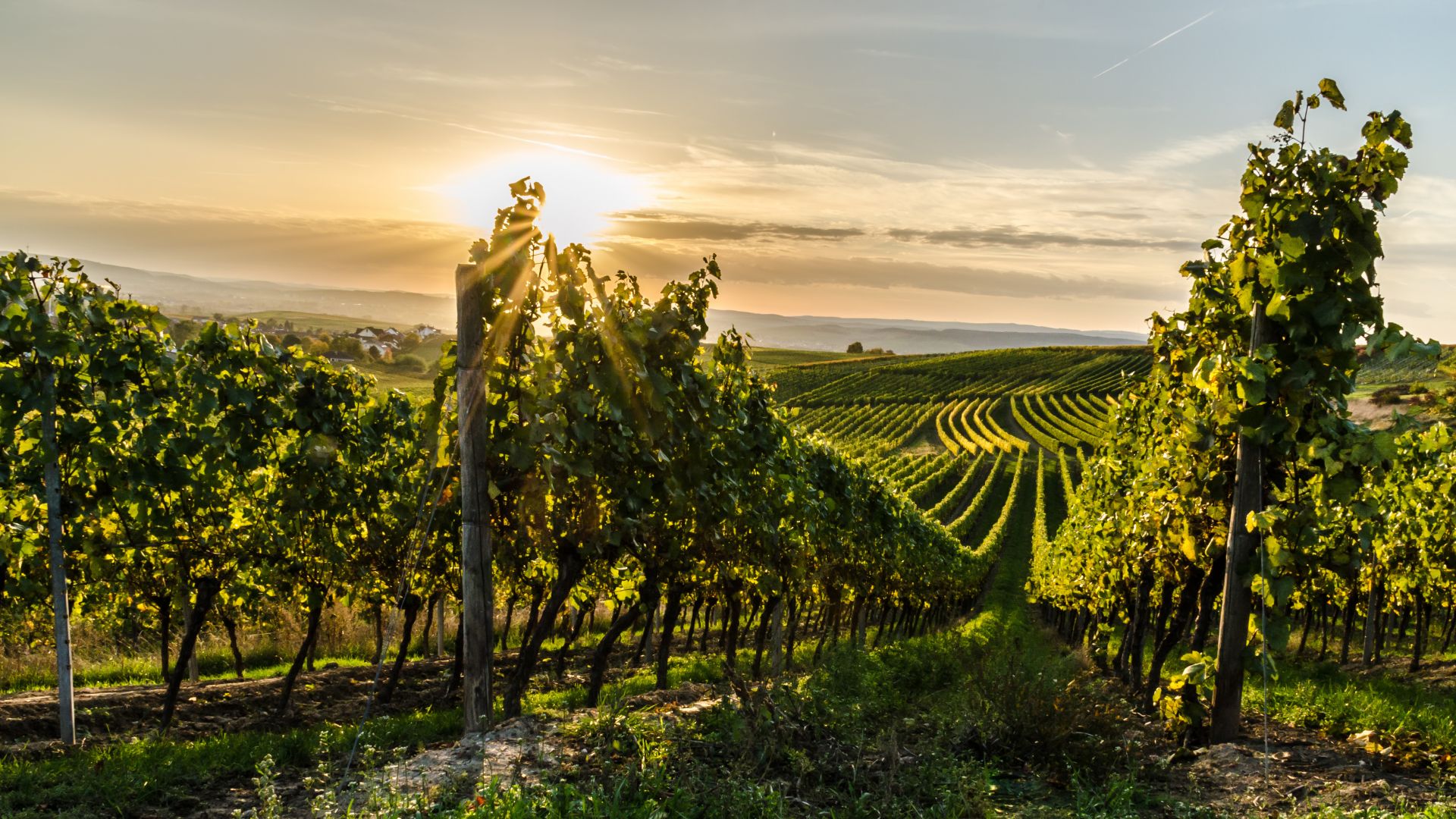 Horrweiler: Vineyard in the sunlight in Rheinhessen near Horrweiler
©Adobe Stock (riebevonsehl)
Horrweiler: Vineyard in the sunlight in Rheinhessen near Horrweiler
©Adobe Stock (riebevonsehl)
The route between Worms and Osthofen, for example, or from Oppenheim to Nackenheim, as well as the walk from Bodenheim to Mainz, are ideal hikes. In Worms and Mainz numerous sights await you, as well as cosy pubs. Also good: the circular trail "Weinerlebnis Roter Hang" and in Oppenheim there is even a gourmet hike, which includes wine. The vantage point at the Brudersberg was voted the Most Beautiful Wine View of 2012.
Situated in the Palatinate: Germany's Oldest Wine Route
The grapes for Riesling, Pinot Blanc, Silvaner or even Chardonnay also come from the Palatinate. The region between the Palatinate Forest and the Rhine Plain is located in Rhineland-Palatinate, bordering Alsace in the south. In terms of landscape, this region is of course strongly influenced by wine, with endless vines reaching in soft sweeps down to the Rhine and Moselle. The winters are mild, the summers pleasant. Lemons, figs and kiwis grow in the country gardens. It is a blessing that Germany's oldest wine route runs through the middle of the Palatinate: the German Wine Route. At 85km in length, it starts at the German Wine Gate in Schweigen Rechtenbach on the French border and ends in Bockenheim on the edge of the Rhine-Hesse. There are 130 idyllic wine villages in between, stately castles and palaces, wine festivals in summer and almond blossoms in spring. The small towns of Bobenheim, Birkweiler and Neustadt are regarded as particularly beautiful.
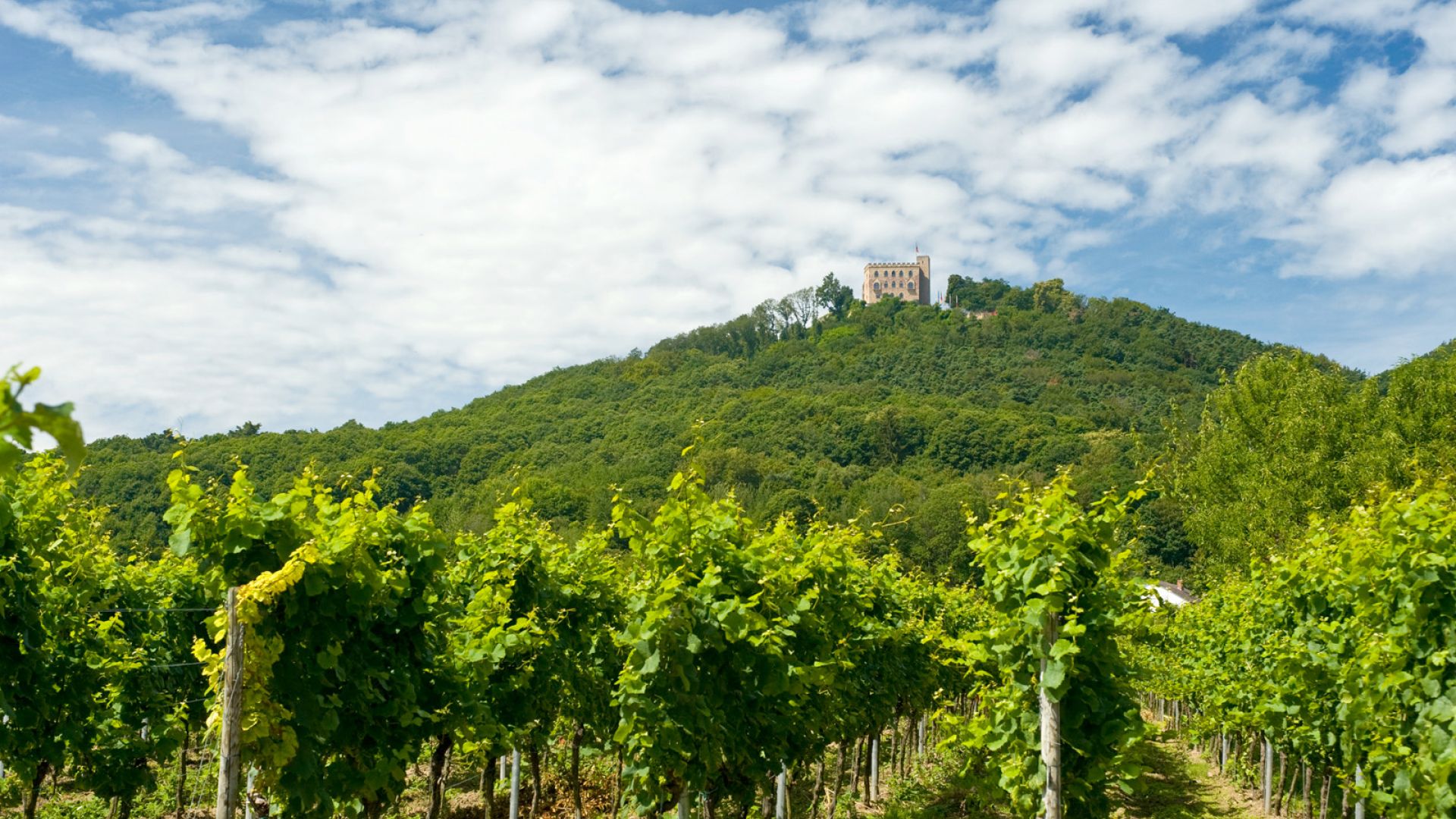 Neustadt: Wine-growing landscape with Hambach Castle
©Rheinland-Pfalz Tourismus GmbH (Dominik Ketz)
Neustadt: Wine-growing landscape with Hambach Castle
©Rheinland-Pfalz Tourismus GmbH (Dominik Ketz)
We recommend the Palatinate Keschde Trail for hiking, as well as the Palatinate Almond Trail and the Palatinate Wine Trail.
Lovely Weather, Wonderful Wine: Baden
Baden, the "Burgundy Paradise" is one of the most versatile wine-growing regions in Germany, and this may have something to do with the fact that it stretches about 400 kilometres along the Upper Rhine Plain from Tauberfranken through Kraichgau and the Badische Bergstrasse to Lake Constance. Therefore it is ideal for many different varieties of grape. And the sun plays along too, so the highest temperatures in Germany are measured on the southern slopes of the Kaiserstuhl. And since Burgundy grapes are particularly fond of the warm climate, Baden is especially well-known for this variety. Another Baden speciality: the Cuvée wine. Famous cities in this region are Freiburg, Heidelberg, Baden-Baden with their beautiful Old Towns, but also the atmospheric Lake Constance, with scattered orchards and picturesque villages.
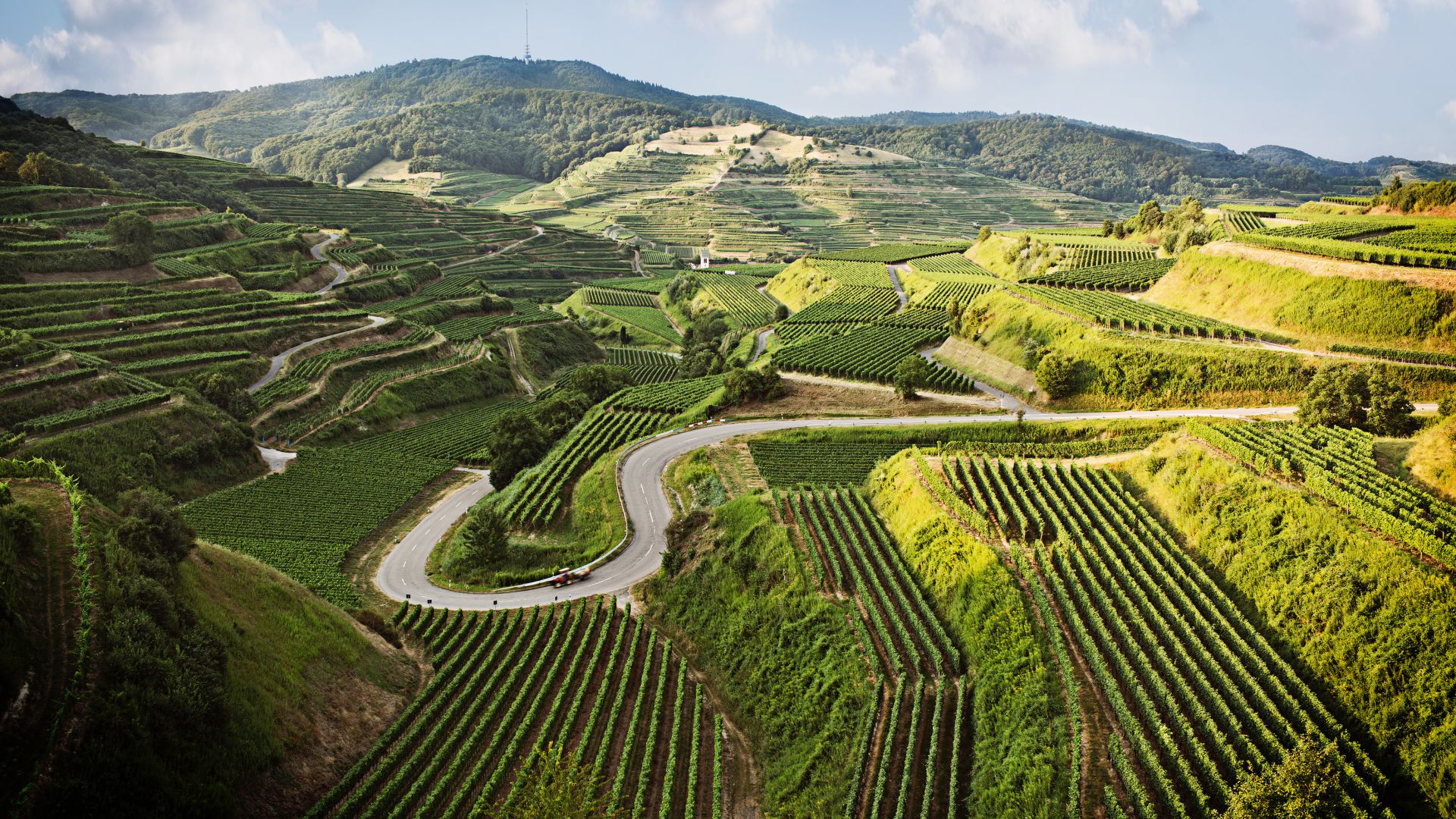 Baden wine growing region, the Kaiserstuhl hills
©Deutsches Weininstitut GmbH
Baden wine growing region, the Kaiserstuhl hills
©Deutsches Weininstitut GmbH
The Baden Wine Route passes through many of these cities. An eco-wine trail also leads through the Markgräfler Land, and wine is also tasted here. The view from the dainty half-timbered village of Sasbachwalden, located between the slopes of the Hornisrinde and vineyards with a view of France, the Rhine Valley and Strasbourg, is especially pretty. The Ortenau Wine Trail is also well worth a mention.
Moselle: head up along the steepest vineyard in Europe
It is one of the oldest wine regions in the country and the steep slopes characterise the area like no other wine landscape in the world. We are, of course, talking about the Moselle region. Here is where the steepest vineyards in Europe are located, and Rieslings as well as Müller-Thurgau and Pinot Noir grow on the primeval shale. The steep slopes are made for experienced hikers and allow unique views of an enchanting cultural landscape with castles, vineyards, waterfalls, ostrich farms and legendary wine villages. Cochem and Bremm are popular towns and the town of Beilstein with its chapels, castle ruins and town wall is certainly worth a visit.
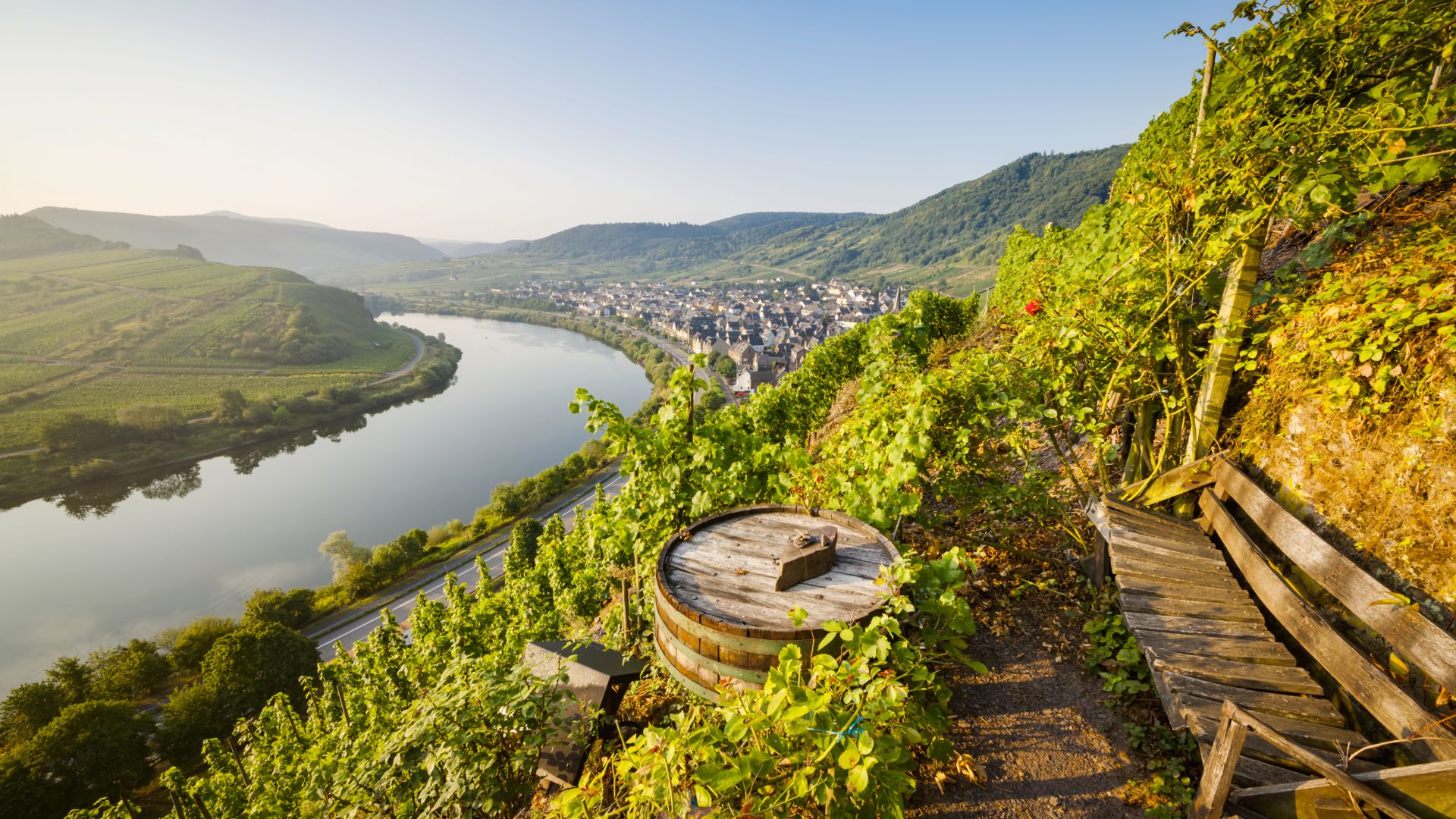 Bremm:The Calmont, Europe's steepest vineyard, view over the Moselle at dusk
©Getty Images (Jörg Greuel)
Bremm:The Calmont, Europe's steepest vineyard, view over the Moselle at dusk
©Getty Images (Jörg Greuel)
The Calmont ropeway offers hikers a unique view of the Bremmer Mosel loop, and a walk to the Prinzenkopf with its steel lookout tower is also recommended. Those who decide to take a tour on Moselhöhenweg will be rewarded with an impressive view of kilometres of ornately arranged wine terraces. And those who trek along the wine trail on the Petrisberg will also be rewarded with a view of Germany's oldest city, Trier. Also good: the culture trail in the Moselle valley
Quite small, but very refined: Franconia
In the Middle Ages, Franconia was still seen as the largest wine region in the Holy Roman Empire; today it is one of the more moderately-sized wine-growing regions. The region's trademark - the bulbous bottle, the Bocksbeutel. The region surrounding Würzburg stretches from Aschaffenburg along the Mainschleife to Bamberg, but also includes the steep slopes of the Steigerwald. Müller-Thurgau, Silvaner as well as Riesling and the typical Franconian Bacchus are grown here. In Franconia, however, it is not just wine that is cultivated. Every year, 200 wine-related festivals take place here. Nestled between the Spessart, Rhön, Steigerwald and Tauber valleys are romantic wine-growing villages, the Marienburg fortress and the residential city of Würzburg, with its imposing cathedral. You can hike through thick forests, gentle hills, and pass by villages with half-timbered houses.
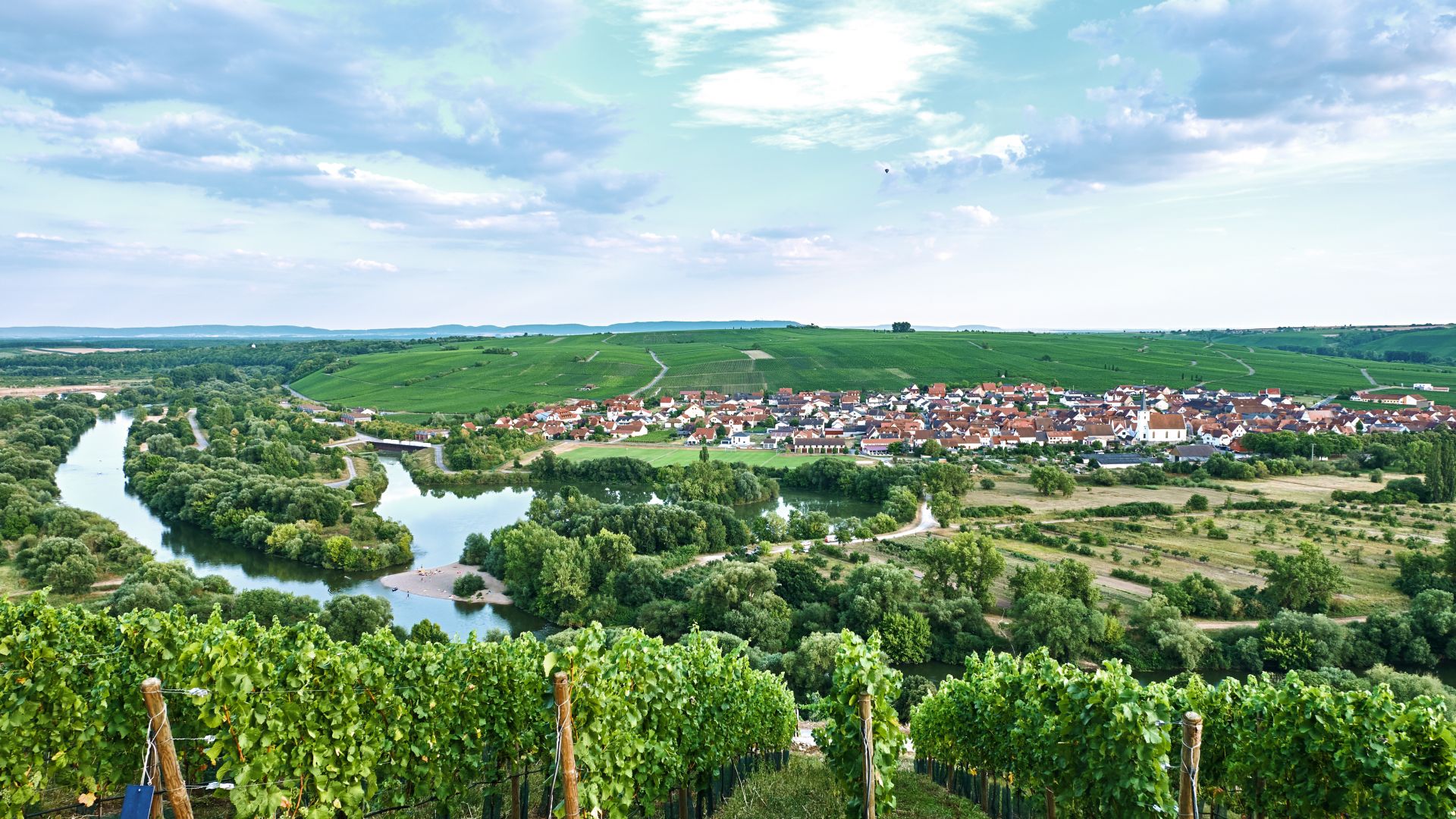 Vineyards along the river Main, Mainschleife
©Because You Are Hungry (Benedikt Steinle)
Vineyards along the river Main, Mainschleife
©Because You Are Hungry (Benedikt Steinle)
Follow the Franconian wine country, for example, on the Main hiking trail with its six stages. The route from Retzbach to Karlstadt or from Rothenfels to Kreuzwertheim is a good option. Along the Volkacher Mainschleife, you can expect Silvaner wine and a breathtaking view of Vogelsburg. Red wine lovers can go on the Red Wine hike to Dernau.